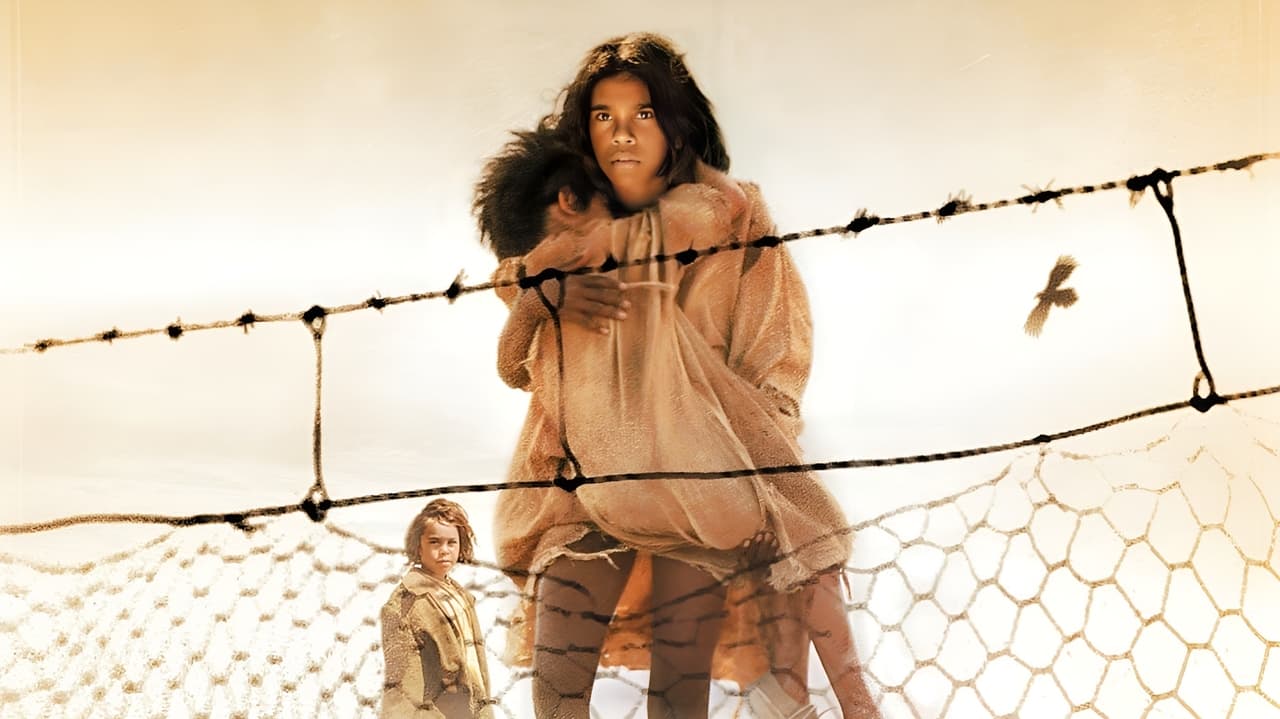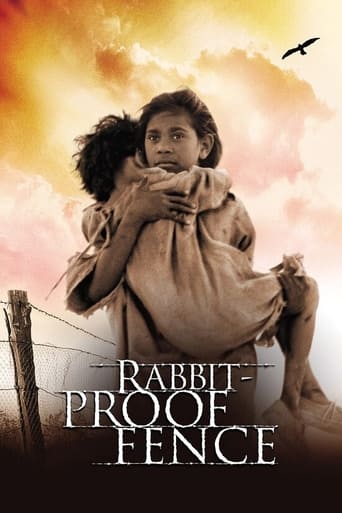

A great movie, one of the best of this year. There was a bit of confusion at one point in the plot, but nothing serious.
... View MoreGreat story, amazing characters, superb action, enthralling cinematography. Yes, this is something I am glad I spent money on.
... View MoreOne of the most extraordinary films you will see this year. Take that as you want.
... View MoreA great movie, one of the best of this year. There was a bit of confusion at one point in the plot, but nothing serious.
... View More"Rabbit-Proof Fence" is a 2002 film and it is a real winner. It is directed by Phillip Noyce. The book is by Doris Pilkington and the screenplay is by Christine Olsen. The cast includes Evelyn Sampi, Tianna Sanbury, Laura Monaghan, David Gulpilil, Ningali Lawford, Myann Lawford, Deborah Mailman, Jason Clarke and Kenneth Branagh. The film is told in a steady, unsentimental tone that allows the film to be powerful without the typically Hollywood use of sweeping music or other such lazy tools. Instead the circumstances of the story create the emotion. The story is a little weak at some points – once the children escape the film has a touch too many scenes of near-capture and escape to sustain the drama. Also the film (understandably) lends a lot of respect to the Aborigines – giving them a sense of mysticism that they maybe don't deserve. This is a slight problem when a key action involves a hawk that is supposedly summoned by their mothers (or something!). However these are minor complaints given the sweeping emotion of the film and the sheer power of the story. I gave this film 9 stars.
... View MoreRabbit-proof Fence (2002) is a story of three young girls who were from their homes was for "ethnic cleansing" purposes by the protagonists. Called "half-caste" children, they were considered a type of third race, and science was unable to do DNA and blood tests so they backed their reasoning by showing photographs of different generations of 'breeding out' the native aboriginal blood. After escaping from Moore River, a dormitory resembling a compound, they are tracked by a professional tracker and outsmart him, an ironic twist in the fact that they were taken from home to isolate the dark-skinned "less intelligent" girls from the rest of society. Two girls make the long journey, and even after returning home, they escape with their mother into the desert where the antagonist Molly is eventually caught and returned to the camp. When I first started watching this film, I thought perhaps the girls were being stolen for slavery purposes. The constables who led the search for the girls justified their morals by saying they were doing this for the children's own good, and to help society by reabsorbing the aboriginals back into "white" culture (where the lightest skinned children were spared from the grim dormitory lifestyle for real schools because they were supposedly more likely to succeed). In the 1930's Australia was still suffering major debts and depression after WWI. In "Culture And Customs of Australia", author Laurie Clancy says:"Farmers were forced off their land, city-dwellers were evicted from their homes and often took to the road in search of subsistence. Shanty towns grew up, with police constantly moving vagrants along." Women with children were considered a financial debt, and children "an unnecessary burden." (p. 29)This explains why there was nobody willing to stand up for these children, although they do meet sympathetic strangers along the way. Another thing I learned from researching the history of Australia is that the children who became survivors still struggle with cultural identity and family issues. They are known as the "Stolen Generation". This film was comparable to "12 Years A Slave" where actor Solomon Northup is drugged and sold into the black market as a slave, regardless of the fact that he has his papers declaring him a free man. The first time we see his character cry is for someone else; in Rabbit-proof Fence the eldest girl Molly (still a baby herself at 12 years old) cries only after the first hour of the movie when her sister is taken. Solomon sees other captive slaves hung and beaten for escape yet he waits for his moment; Molly does the same, convincing her sisters to join her when the time is right. Solomon had strip naked and share a washtub with others as guards looked on, stealing their modesty. Molly is washed by the nuns in an outside shower and has to defecate into a bucket in the corner of the over-crowded dormitory. Both characters have their rights stripped away from them, and at this point death is a better alternative to their certain miserable future. Though these movies are both based on history of a hundred years ago, the themes of racism and dominating of others persists in our country and others around the world today. Mixed- race couples in America get ostracized for marriage and for having children, although modern science clearly shows we are ALL mixed race of some sort or another and that there IS no "full- blood" in America today. Some gays and lesbians have even adopted the word "queer" to self- define, a way of stripping the derogatory power of that word from society. Many issues regarding aborigines still persists throughout Australia today, with two schools of thought regarding whether they should be isolated or "reabsorbed" back into society and given the same rights and opportunities as fair skinned settlers. has Clancy's book speaks of this disparity, and of today's gender issues in the country. Did you know that "Waltzing Matilda", the unofficial song of Australia, has nothing to do with a woman dancing, but refers to the swag of cloth or "matilda" worn by bushmen? I also learned that it wasn't until 1962 that aboriginals gained the right to vote! This is a great film, and the true story behind it is worth looking into.
... View MoreThe movie Rabbit Proof Fence is a story concerning the Stolen Generation in Australia. Very many half caste kids (one of the parents was white, and the other one, usually the mother, was aborigine) were taken by the white population in Australia by force and sent to schools or institutions that were going to train them into being white. A man called Mr. Neville, the Chief Protector of Aborigines in Western Australia, had the responsibility to decide over the aboriginal population, and from what they knew about the aborigines and the whites, it was with good intentions that they took the children away. They were supposed to mix the aborigines with the white population and eventually the aborigines would die out.This movie is a true story about how three girls, Molly, Gracie and Daisy, who were half caste children, were taken away from their mothers and put in an institution very far from where they lived. They soon made an attempt to run away, and they used a fence that stretched through the country to navigate. The fence was called a rabbit proof fence because it was there to prevent that the rabbits would ruin the agriculture on the other side. During this journey the girls always had to hide and cover their tracks. An aborigine who worked for the whites, Moodoo or "the Tracker", was following them. The oldest of the girls was Molly; she was only 14 years old.Molly, Daisy and Gracie changes throughout the movie, they are dynamic characters. What they experience makes them more grown-up. The girls' families are flat characters.The story about the three girls is true, it happened in the 1930's, and at the end of the movie, we get to hear about the real story and how it ended. Since the story is true, the creator of the film had some guiding lines to follow. The setting is put to the 1930's and the setting is very natural, most of the movie takes place in the Australian outback/desert.The most important thing about the movie is when the girls are taken away, and their journey home. The relationship between the aboriginals and the white population is something we can learn more about in this movie.I liked the movie because it is a true story about three young girls who had courage and a determination that everybody could look up to. The movie doesn't have a proper climax, and if you are a person who like when something happens in movies, this movie might not be the best choice. But I would recommend it anyway because of the historical aspect.
... View MoreRabbit proof fence is a powerful movie by Philip Noyce. It is set in Australia during the 1930s. Three Aboriginal girls, Gracie, Daisy and Molly, are forcibly taken away from their family home in Jigalong, Western Australia and taken 1,200 miles away to Moore River to be trained as domestic servants, part of official Australian Government policy. The film is basically about their struggle for freedom, and how three little girls walk the long way home. This is a story that moves the heart. The strength of the girls and the cruelty of the Australian government are truly overwhelming. The heartless comments and actions of the government are baffling. I think it is good to make people aware of these horrible incidents. Moreover, I think this film is quite well made, strictly technical. I like the way the film contains lots of strong pictures and strong colors. The real footage that we see at the end of the film is so powerful that the whole essence of what you have just watched becomes even more devastating.I think this movie can be educational and good for any teenagers. It is a part of Australian history that should not be hidden, rather enlightened and discussed. Strictly personal, I didn't find this movie exiting or very entertaining, but more educational.
... View More